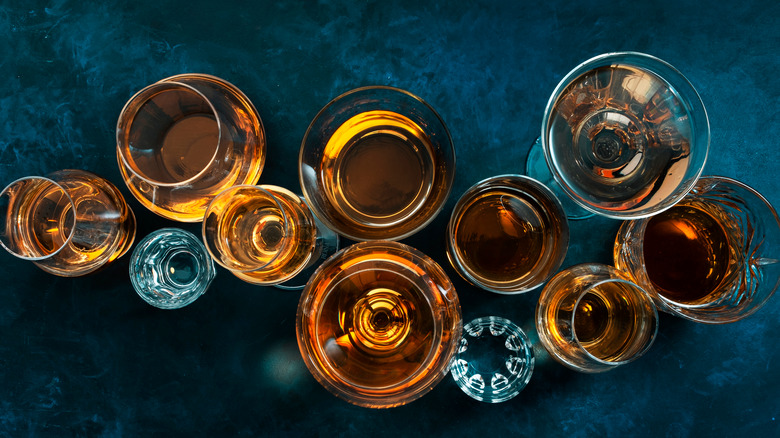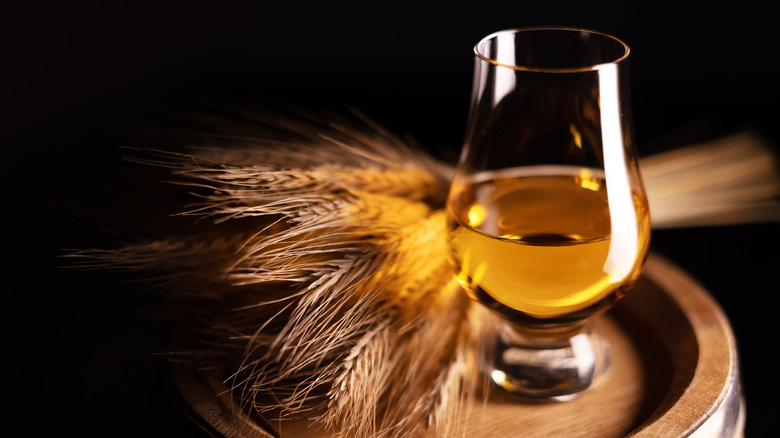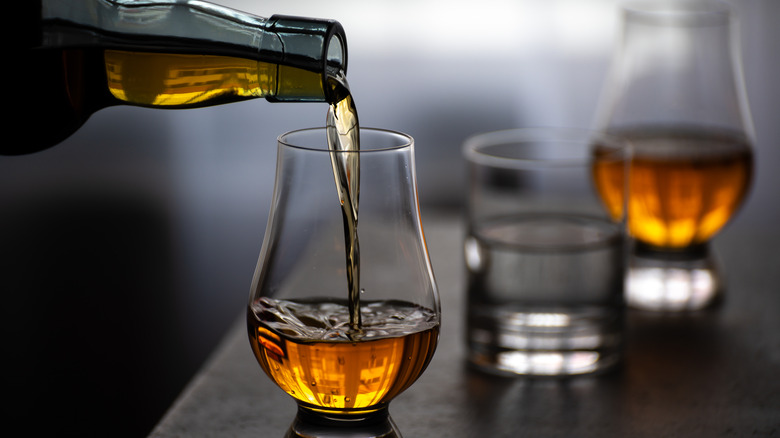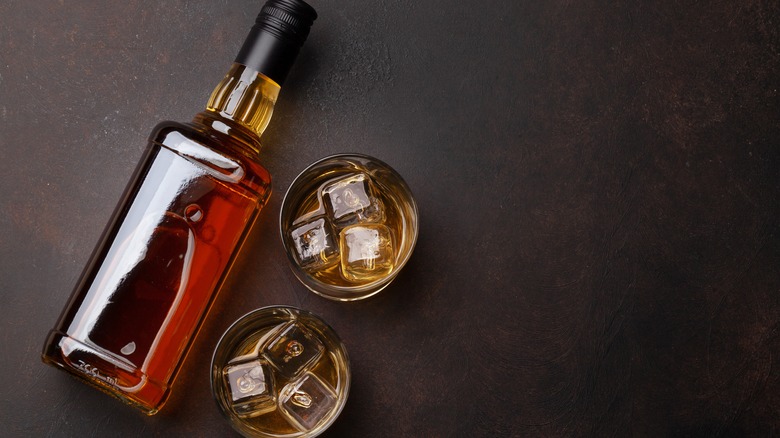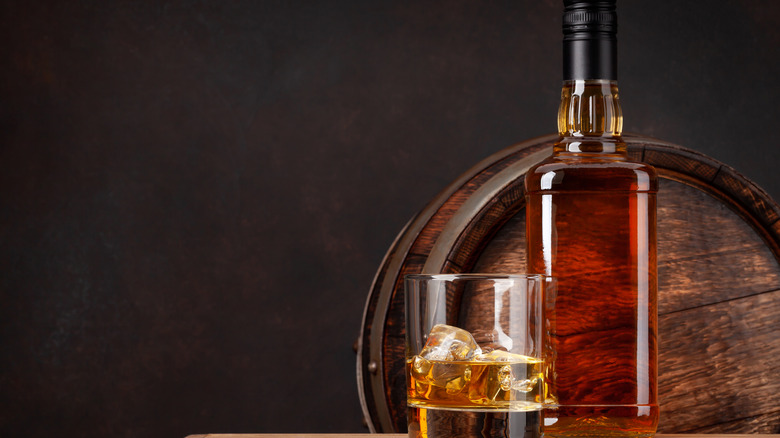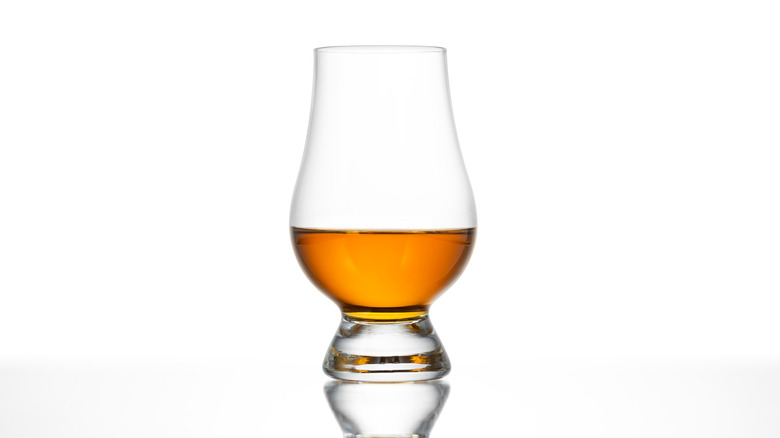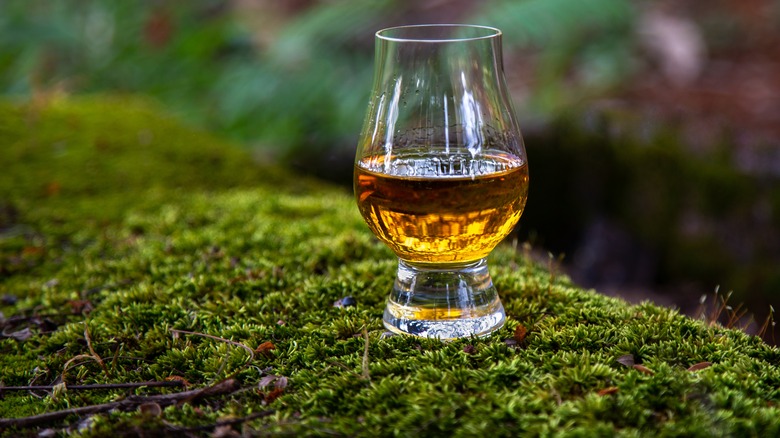6 Types Of Scotch Whisky And How They Differ
The vast world of spirits can be confusing, especially when it comes to Scotch. This beloved libation is a type of whisky, and everything from the way it's spelled (whisky, not whiskey), to where it comes from, to how it's aged help set it apart from other varieties such as bourbon.
The difference between bourbon and Scotch can be broken down by a few main distinctions. First, as its name suggests, Scotch must be made in Scotland. It also uses barley as the primary grain. Finally, unlike bourbon, which isn't subject to aging requirements, Scotch must be aged for at least three years — although many varieties are aged for much, much longer.
Once you understand what qualifies as Scotch, the next thing to wrap your mind around is that there are several varieties of Scotch that each have their own set of requirements and characteristics. Released in 2009, the Scotch Whisky Regulations outline five main categories. Beyond these legally defined divisions, there are also unique regional styles of Scotch. To help understand the nuances between the main types of Scotch whisky, we reached out to Scotch expert David Allardice, a U.S. Ambassador for Glenfiddich.
"If you've enjoyed a Scotch whisky, you might be familiar with the two most commonly found classifications: blended Scotch whisky and single malt Scotch whisky," Allardice says. "But we never said these were easy categories to understand, and there are three other lesser-known styles that fall under the umbrella of Scotch whisky."
Single malt
Even if you aren't much of a Scotch drinker, you've probably heard the term "single malt" being thrown around in reference to this type of whisky. According to David Allardice, it's the "second most common category of Scotch whisky." There are a few notable requirements these bottles must meet in order to be labeled as such. Single malt Scotch must be "produced at one single distillery using only malted barley as the grain, and distilled in individual batches using copper pot stills," Allardice says.
While single malts have name recognition on their side, there is a good deal of misinformation out there about this variety. "A common misconception is that there are categories of Scotch whisky named single malts and double malts," Allardice explains. "A single malt is a correct term — the product of malt whisky from one distillery — but there is no such classification for 'double malt.'" Many people also wrongly believe that the "single" in single malt refers to a single barrel, when in reality it references the single distillery from which the blend was produced.
Some of Allardice's go-to bottles fall under this category. "The type of Scotch I normally reach for is either something well-balanced and rich in flavor such as Glenfiddich's 15 or 18 Year Old, or The Balvenie 14 Year Caribbean Cask," Allardice says. "If I'm celebrating or would like to really impress someone, I'd go for the Glenfiddich Grand Cru 23 Year Old, which has spent the final few months of its life aging in French Oak barrels that were previously used in the production of fine sparkling wines from France."
Blended malt Scotch whisky
So, if single malt whisky comes from a single distillery, what happens if the whisky comes from more than one producer? "If you blend two malt whiskies from two different single malt Scotch whisky distilleries, you would have a 'blended malt Scotch whisky,'" David Allardice says.
The key thing to be aware of here is that although this variety comes from more than one distillery, the other requirements of single malt scotch still hold. This means that each of the whiskies that constitute the blend must be made from 100% barley and produced in copper pot stills. Since the whiskies in blended malt Scotch can come from different producers —each with their own unique style and flavor profile — there is a significant amount of room for innovation within this category. According to The Whisky Exchange, there is no limit to the number of whiskies each bottle of blended malt can contain, and popular bottles range from including three to 16 producers.
Though not as common as single malt varieties, there are well-known brands and bottles that fall into this category. "An example of this within our portfolio is Monkey Shoulder," says Allardice.
Single grain Scotch whisky
This is where things start to get confusing. "A single grain whisky is produced at one single distillery but can be made using any grains including barley, wheat, corn, etc. It must be distilled using a column still, not copper pot stills," David Allardice explains.
Single grain whisky is allowed to contain more than just malted barley, and this additional grain (or grains) can be either malted or unmalted (via Distiller). Single grain whisky often rings in at a lower price point than its single malt counterpart, so when you're looking for a type of Scotch that will transport you to Scotland, single grain whiskies are great choices to use in Scotch-based cocktails, such as the Blood and Sand, which is named after a silent film.
The flavor of single grain whisky is often lighter than other varieties and is usually blended with single malts to create yet another variety called blended Scotches (more on that later). However, despite traditionally being used in blends, some distillers are now bottling and selling single grain whisky as-is.
Blended Scotch whisky
"Blended Scotch whisky is a blend of one or more single malt whiskies with one or more single grain whiskies," David Allardice explains. Since single grain whiskies (which, as we discussed above, can contain more than just malted barley) are allowed into the mix, blended scotches can contain different malted and unmalted grains.
Although this category might not have the same type of clout that single malt carries, it's extremely prevalent. It's "the style that is most commonly found globally," Allardice says. In fact, according to The Scotch Advocate, blended scotch makes up a whopping 90% of the overall Scotch market. Major brands like Johnnie Walker and Dewars are blends, and blends often represent drinkers' first brush with the spirit.
As common as blended Scotches may be, not all blends are necessarily affordable, and there are plenty of expensive, high-end blended Scotches out there. For example, Johnnie Walker Blue Label is a top-shelf blended option that isn't hard to find — as long as you're willing to pay the average sticker price of $229 per bottle.
Blended grain Scotch whisky
The final official variety of Scotch is called blended grain Scotch whisky. According to David Allardice, this type of whisky is made from "the blending of two or more single grain whiskies from different distilleries." Unlike blended malt varieties, none of the individual whiskies that make up blended grain Scotch meet the requirements of single malt.
This type of Scotch is known for being mild, mellow, and light. It's also not very common, but there are some notable bottles out there. You might have to look a little harder for blended grain whiskies, but if you're serious about expanding your palate and knowledge, you shouldn't let this category fall through the cracks.
According to Find My Whisky, blended grain Scotch is lighter than other varieties. It also allows the flavors of the other grains in the mash — such as rye, oats, and wheat — to shine, unlike Scotch that's only made from barley.
Regional variations
Though these distinctions don't fall under the legally defined types of Scotches, there are several unique regional varieties of Scotches that are made throughout the country. The five main regions of Scotland that produce Scotch are Highland, Lowland, Speyside, Campbeltown, and Islay.
Although regionality is important, the overall type of Scotch, as well as each distillery's method of production, is more important. "Scotch whisky is a diverse category, and it's often difficult to attach flavor characteristics to any of the so-called regions of Scotch whisky," David Allardice says. "Islay is the one exception, as most of the whisky from the west coast island of Islay tends to be of the more heavily peated style."
Glenfiddich, the Scotch brand which Allardice represents, is a Speyside Scotch. "There is no singular defining flavor characteristic of a whisky from Speyside. Each distillery creates its own unique style. Some light and fruity, others more rich and honeyed, and on occasion, some may even be lightly peated," Allardice says.
